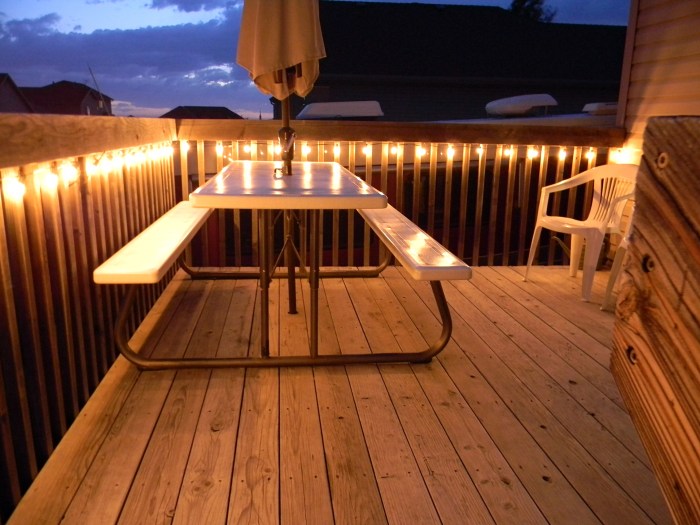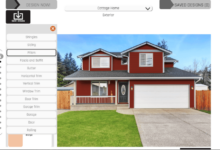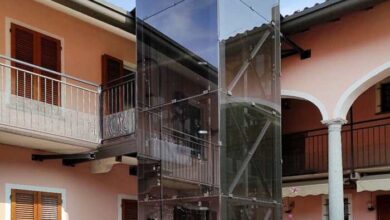Outdoor Elevators for Decks A Comprehensive Guide
Outdoor Elevators for Decks: Imagine effortlessly accessing your deck, regardless of age or mobility. This guide explores the world of outdoor elevators designed specifically for deck integration, examining various types, installation considerations, safety features, maintenance needs, and design aesthetics. We’ll delve into the technical aspects, comparing different systems and outlining the necessary steps to ensure a safe and stylish addition to your home.
From understanding structural requirements and navigating building permits to choosing eco-friendly materials and minimizing environmental impact, we cover everything you need to know before embarking on this exciting project. We’ll also highlight cost-saving strategies and discuss seamless integration with existing or planned deck designs, focusing on accessibility for all.
Types of Outdoor Elevators for Decks
Choosing the right outdoor elevator for your deck involves careful consideration of several factors, including budget, space constraints, aesthetic preferences, and the specific needs of the users. Different types of elevators offer varying advantages and disadvantages, making it crucial to understand the nuances of each before making a decision. This section will explore the most common types of outdoor deck elevators.
Hydraulic Outdoor Elevators
Hydraulic elevators use a hydraulic piston to lift the elevator car. A pump forces hydraulic fluid into the piston, causing it to extend and raise the elevator. These systems are generally known for their smooth operation and relatively low initial cost compared to other types. However, they require a pit beneath the elevator for the piston to retract into, which can present a significant space limitation, especially for decks with limited ground clearance.
Furthermore, hydraulic systems often require more frequent maintenance due to the wear and tear on the hydraulic components. They also tend to be less energy-efficient than other options. A typical hydraulic elevator for residential use might have a capacity of around 1,000 lbs and a speed of approximately 20 feet per minute.
Pneumatic Outdoor Elevators
Pneumatic elevators utilize compressed air to lift the elevator car. This method often requires less space than hydraulic systems because they don’t need a deep pit. The compressed air pushes a piston or bellows, raising the elevator. Pneumatic elevators are generally quieter than hydraulic ones and are known for their relatively low maintenance requirements. However, they typically have lower lifting capacities and slower speeds than hydraulic elevators, making them less suitable for heavier loads or taller lifts.
Outdoor elevators for decks offer convenient access to upper-level decks, enhancing accessibility and enjoyment. However, consider the overall aesthetic; a well-designed deck complements the home’s style, much like a thoughtfully planned Kitchen Decorating scheme. Therefore, choosing an elevator that harmonizes with the deck’s design and the overall house architecture is crucial for a cohesive and visually appealing result.
The cost can also be higher than basic hydraulic systems, particularly for larger installations.
Cable-Lifted Outdoor Elevators (Electric)
Cable-lifted elevators, also known as traction elevators, use a system of cables and a motor to lift the elevator car. These are generally considered the most reliable and efficient type, offering higher speeds and capacities than hydraulic or pneumatic systems. They are also more energy-efficient in the long run. However, cable-lifted elevators typically require more space for the machinery room and guiding system, which can be a significant drawback for decks with limited space.
The initial cost is generally higher than hydraulic or pneumatic systems, and the maintenance requirements, while less frequent than hydraulic systems, can be more complex and expensive.
Comparison of Outdoor Elevator Types
The following table summarizes the key features of the three types of outdoor elevators discussed:
| Feature | Hydraulic | Pneumatic | Cable-Lifted (Electric) |
|---|---|---|---|
| Capacity (lbs) | 500-2000 | 250-1000 | 1000-4000+ |
| Speed (fpm) | 15-30 | 5-15 | 25-100+ |
| Power Source | Hydraulic pump (electric motor) | Compressed air (electric compressor) | Electric motor |
| Safety Features | Emergency stop, pressure relief valve | Emergency stop, pressure relief valve | Emergency stop, overspeed governor, safety brakes |
Deck Design Considerations for Elevator Installation
Installing an outdoor elevator on a deck requires careful consideration of the deck’s structural integrity and compliance with building codes. Failing to adequately address these factors can lead to instability, safety hazards, and potential legal issues. This section details the crucial design considerations for a successful and safe elevator installation.
Outdoor elevators for decks offer convenient access to elevated spaces, enhancing accessibility and property value. This is particularly relevant when considering significant exterior renovations, such as those detailed in this guide on Colonial Home Exterior Updates , where careful planning is key. Adding an outdoor elevator can complement a beautifully restored Colonial home, providing both modern convenience and classic charm.
Structural Requirements for Deck Support
The deck must possess sufficient load-bearing capacity to safely support the elevator’s weight, including the elevator cab, counterweights, machinery, and the anticipated passenger load. This requires a thorough structural assessment by a qualified engineer. The assessment should consider the deck’s existing framing, materials (e.g., wood, composite), and overall condition. Reinforcements, such as additional beams, posts, or foundation support, may be necessary to meet the increased load demands.
For example, a deck originally designed for light residential use might require significant upgrades to accommodate the weight of a modern elevator system, which can easily exceed several thousand pounds. The engineer’s report will specify the necessary modifications and ensure compliance with relevant building codes.
Building Permits and Inspections
Securing the necessary building permits and undergoing inspections are critical steps in the elevator installation process. These procedures ensure the project adheres to local building codes and safety regulations. The permit application will typically require detailed plans, specifications, and engineering calculations demonstrating the deck’s structural adequacy to support the elevator. Inspections will be conducted at various stages of the installation, including foundation work, elevator shaft construction, and final system testing.
Failure to obtain permits or pass inspections can result in delays, fines, and even the forced removal of the elevator. It’s advisable to consult with local building authorities early in the planning process to understand specific requirements and timelines.
Outdoor elevators for decks offer convenient access to elevated spaces, enhancing both accessibility and enjoyment. However, furnishing a deck, whether elevated or ground level, can be surprisingly costly; this is where exploring options like Thrifting Furniture comes in handy. Finding unique and affordable pieces can significantly reduce the overall cost of your deck project, leaving more budget for the elevator installation itself.
Foundation Types for Outdoor Elevators
The choice of foundation type depends on several factors, including soil conditions, the elevator’s weight, and the deck’s design. Common foundation types include:
- Spread Footings: These are suitable for decks built on stable, well-drained soil with sufficient load-bearing capacity. Spread footings distribute the elevator’s weight over a larger area, reducing pressure on the soil. The size and depth of the footings will be determined by the engineer based on soil testing and load calculations.
- Pier Footings: Used when the soil is less stable or the load is high, pier footings transfer the weight to deeper, more stable soil layers. They consist of concrete piers driven into the ground, topped with a footing that supports the elevator’s structure. This is a common solution for decks built on sloping terrain or areas with soft soil.
- Pile Foundations: For extremely challenging soil conditions, such as loose sand or highly saturated clay, pile foundations may be necessary. These involve driving long, slender piles deep into the ground to transfer the load to a stable stratum. Pile foundations are more complex and expensive but provide superior support in difficult soil conditions.
Soil testing is crucial to determine the appropriate foundation type and design. A geotechnical engineer will conduct tests to assess the soil’s bearing capacity, settlement characteristics, and potential for erosion. This information is essential for designing a foundation that can reliably support the elevator’s weight over its lifespan, preventing costly and potentially dangerous failures.
Safety Features and Regulations: Outdoor Elevators For Decks

Source: co.uk
Ensuring the safe operation of an outdoor deck elevator is paramount. Several crucial safety features and adherence to stringent regulations are vital for protecting users and preventing accidents. These systems are designed to mitigate risks associated with the outdoor environment and the mechanical complexities of the elevator itself.The primary safety features work in concert to provide a secure ride.
These features address potential hazards from mechanical failures, weather conditions, and user error. Compliance with building codes and industry standards is non-negotiable for legal operation and user safety.
Essential Safety Features, Outdoor Elevators for Decks
Outdoor deck elevators incorporate a range of safety features to minimize risks. These features are designed to prevent accidents and protect users in the event of malfunctions or emergencies. Regular maintenance and inspection are crucial for ensuring the continued effectiveness of these systems.
Outdoor elevators offer convenient access to elevated decks, enhancing both functionality and aesthetics. For coastal properties facing the unique challenges of saltwater and harsh weather, a robust solution is needed, such as the specialized designs offered by Coastal Outdoor Elevator. These elevators are engineered to withstand the elements, ensuring reliable operation and long-term performance for your deck access, ultimately providing a safe and enjoyable experience.
- Emergency Stop Buttons: Strategically placed emergency stop buttons allow immediate halting of the elevator’s operation in case of any unforeseen event. These buttons are typically bright red and clearly labeled for easy identification.
- Safety Brakes: Multiple redundant braking systems are incorporated. These brakes engage automatically in the event of power failure or other malfunctions, preventing a freefall. They are often fail-safe, meaning they activate even if other components fail.
- Weather Protection: Enclosures and weather-resistant components shield the elevator’s mechanical parts and electrical systems from rain, snow, and extreme temperatures. This protects against corrosion and ensures reliable operation in all weather conditions. Proper sealing and drainage are critical design elements.
- Overload Protection: Sensors monitor the elevator’s weight capacity, preventing operation if the maximum load is exceeded. This protects against structural damage and ensures user safety. A warning system alerts users to potential overload situations.
- Communication Systems: Two-way communication systems allow occupants to contact emergency services or maintenance personnel in case of a malfunction or emergency. This enables prompt assistance and reduces response times. The system may include an intercom or a direct line to a monitoring service.
Relevant Safety Regulations and Codes
Installation and operation of outdoor elevators are subject to stringent safety regulations and building codes that vary by location. These codes often align with national standards set by organizations like ASME (American Society of Mechanical Engineers) and local building departments. Compliance is essential to ensure legal operation and user safety.The specific requirements encompass aspects such as structural integrity, electrical safety, emergency exits, and accessibility standards.
Outdoor elevators for decks offer convenient access to upper levels, enhancing both functionality and aesthetics. Proper illumination is crucial for safety and to highlight this impressive addition to your home; consider consulting resources on Home Exterior Lighting Design to ensure the elevator and surrounding deck are beautifully and safely lit at night. Well-placed lighting can dramatically improve the overall look and feel of your outdoor elevator installation.
Regular inspections and certifications are typically mandated to confirm ongoing compliance with these regulations. Failure to comply can result in fines, operational shutdowns, and legal liabilities.
Typical Safety System Design
Imagine a vertical shaft housing the elevator car. At the top and bottom of the shaft, robust limit switches prevent over-travel. Within the elevator car, a clearly visible emergency stop button is mounted. The elevator car itself is equipped with a robust safety brake system, including both mechanical and electrical components designed to engage instantly in case of power failure or other malfunctions.
A weatherproof enclosure surrounds the entire elevator structure, protecting internal components from the elements. A clearly marked emergency communication panel inside the car allows direct contact with emergency services. This entire system is designed to provide multiple layers of protection, ensuring the safe and reliable operation of the outdoor deck elevator.
Maintenance and Cost Considerations
Owning an outdoor deck elevator involves ongoing maintenance and significant upfront investment. Understanding these costs is crucial for budgeting and ensuring the longevity and safe operation of your elevator. This section details typical maintenance expenses and factors influencing the overall cost of purchase and installation.The ongoing maintenance of an outdoor deck elevator, like any mechanical device exposed to the elements, demands regular attention.
Neglecting maintenance can lead to premature wear, costly repairs, and potential safety hazards.
Typical Maintenance Costs
Routine maintenance typically includes yearly inspections by a qualified technician, lubrication of moving parts, and cleaning of the elevator car and surrounding components. These inspections often identify potential problems early, preventing more extensive and expensive repairs down the line. Beyond routine maintenance, expect occasional part replacements. Hydraulic systems, for instance, might require fluid changes or seal replacements over time.
The frequency of these replacements depends on usage, environmental factors (exposure to rain, sun, and extreme temperatures), and the quality of the initial components. A realistic annual maintenance budget should include a range from $500 to $2,000, with higher-end elevators and more frequent usage justifying the higher end of this range. Unexpected repairs, such as motor replacements or control system malfunctions, can significantly increase annual costs, necessitating a contingency fund.
For example, a faulty motor replacement could easily cost between $2,000 and $5,000, depending on the elevator’s specifications and the technician’s labor costs.
Factors Influencing Purchase and Installation Costs
Several factors significantly influence the overall cost of purchasing and installing an outdoor deck elevator. The size of the elevator, a crucial factor, directly correlates with its cost. Larger elevators, capable of accommodating more passengers or heavier loads, require more robust components and thus are more expensive. The elevator’s features also contribute to the cost. Luxury features such as sophisticated control systems, interior finishes, and accessibility accommodations (for example, ramps or wider cabins) increase the overall price.
Installation complexity plays a significant role. The location of the deck, the terrain, and the need for structural modifications to support the elevator all affect the installation cost. Difficult terrain or extensive structural work can substantially increase the labor costs associated with installation. For instance, an elevator installed on a hillside with challenging access might cost significantly more than one installed on a flat, easily accessible deck.
The initial cost of a basic outdoor deck elevator can range from $20,000 to $50,000, while high-end models with advanced features and complex installations can easily exceed $100,000.
Cost-Saving Strategies
Careful planning and proactive maintenance can help mitigate the overall cost of owning an outdoor deck elevator.
- Regular Inspections: Scheduling annual professional inspections helps detect minor issues before they escalate into major, costly repairs. Early detection allows for less expensive repairs and prevents potential safety hazards.
- Preventative Maintenance: Regular lubrication and cleaning of moving parts extend the lifespan of components and reduce the need for frequent replacements.
- Choosing Durable Materials: Opting for high-quality, weather-resistant materials during the initial purchase can reduce long-term maintenance and replacement costs. Stainless steel components, for example, are more resistant to corrosion than some other materials.
- Protecting from the Elements: Installing a weather-protective enclosure around the elevator’s mechanical components can significantly reduce wear and tear caused by exposure to the elements.
- Establishing a Maintenance Fund: Setting aside a dedicated fund for routine maintenance and unexpected repairs helps avoid financial strain when unexpected issues arise.
Accessibility and Integration with Deck Design
Seamlessly integrating an outdoor elevator into a deck requires careful planning and consideration of both aesthetic and accessibility guidelines. The goal is to create a functional and visually appealing addition that enhances, rather than detracts from, the overall deck design. This involves thoughtful choices in elevator design, material selection, and placement to ensure ease of use for all individuals, particularly those with disabilities.Successful integration hinges on a holistic approach that balances functionality with the existing or planned deck’s style and surroundings.
This includes matching the elevator’s materials and finish to the deck’s overall aesthetic, minimizing visual disruption, and ensuring the elevator’s operation is intuitive and accessible to users of all abilities. Careful consideration of the surrounding landscape and architectural style is also crucial to achieve a cohesive and visually pleasing result.
Ramp Integration and Elevator Control Placement
Proper ramp integration is essential for ensuring full accessibility. A gently sloping ramp, compliant with ADA guidelines, should lead to the elevator platform. The ramp’s surface should be non-slip and provide ample space for wheelchair maneuvering. The elevator controls should be positioned at a height accessible to both seated and standing users, with clear, tactile markings and large, easy-to-read buttons.
Consider including Braille labeling for visually impaired users. For example, a well-integrated system might incorporate a ramp that seamlessly extends from the deck’s existing walkway, leading to an elevator discreetly housed within a custom-built enclosure that mimics the deck’s railing style. The elevator controls could be located on a side panel, easily reached from both wheelchair and standing positions.
Design Features Enhancing Visual Appeal
Several design features can enhance an outdoor elevator’s visual appeal while maintaining functionality. The elevator’s exterior can be clad in materials that complement the deck’s design, such as wood, stone, or metal. The elevator’s doors can be designed to blend seamlessly with the surrounding structure, perhaps incorporating decorative elements that match the deck’s railing or other architectural features.
Careful consideration of the elevator’s size and placement can also contribute to its aesthetic integration. A smaller elevator, cleverly concealed within a custom-built structure, can minimize visual impact while still providing essential accessibility. For example, a modern deck with clean lines might benefit from an elevator with a sleek, minimalist design, using glass panels to maximize natural light and create a sense of openness.
Conversely, a more traditional deck might be complemented by an elevator with a more rustic aesthetic, perhaps using reclaimed wood or stone. In both cases, careful attention to detail will ensure a harmonious blend of form and function.
Environmental Considerations
Choosing an outdoor elevator for your deck involves more than just aesthetics and functionality; it also necessitates careful consideration of environmental impact. The materials used, energy consumption during operation, and the overall environmental footprint of the installation process all contribute to the elevator’s long-term sustainability. Making informed choices can significantly reduce the environmental burden associated with your deck elevator.The environmental impact of outdoor elevator systems is multifaceted.
Energy consumption is a major factor, with different drive systems exhibiting varying levels of efficiency. For instance, hydraulic elevators generally consume more energy than electric elevators, due to the energy required to power the hydraulic pump. The sourcing of materials is another key consideration. The use of sustainably harvested timber, recycled metals, and low-impact concrete can significantly reduce the carbon footprint of the elevator’s construction.
Finally, the manufacturing process itself contributes to the overall environmental impact, with certain manufacturing processes generating more waste and pollution than others.
Energy Consumption and Efficiency
Different elevator systems possess varying energy consumption profiles. Electric elevators, particularly those with regenerative braking systems, are generally more energy-efficient than hydraulic elevators. Regenerative braking systems recapture energy during descent, converting it back into usable power, thereby reducing overall energy consumption. The choice of motor and control system also influences energy efficiency. High-efficiency motors and sophisticated control systems can significantly optimize energy use.
For example, a modern elevator with a variable frequency drive (VFD) can adjust motor speed based on demand, minimizing energy waste. Consideration should be given to the elevator’s expected usage; a high-traffic elevator will require a more energy-efficient system to offset increased energy consumption.
Eco-Friendly Materials and Technologies
The construction of environmentally responsible outdoor elevators utilizes sustainable materials and manufacturing processes. Sustainable timber certified by organizations like the Forest Stewardship Council (FSC) minimizes the impact on forests. Recycled steel and aluminum reduce reliance on virgin materials and lower greenhouse gas emissions associated with extraction and processing. Low-embodied carbon concrete, made with supplementary cementitious materials, reduces the carbon footprint of the concrete components.
Furthermore, the use of low-VOC (volatile organic compound) paints and coatings minimizes harmful air emissions during and after construction. Manufacturers increasingly offer elevators with features such as LED lighting and energy-efficient components, further contributing to environmental sustainability.
Minimizing Environmental Impact During Installation and Operation
Minimizing the environmental impact during the installation and operation phases involves careful planning and execution. Efficient site preparation minimizes soil disturbance and waste generation. Recycling construction debris and using locally sourced materials reduces transportation emissions. Proper disposal of hazardous materials, such as refrigerants and oils, is crucial. During operation, regular maintenance ensures optimal energy efficiency and prevents premature failure, thus extending the elevator’s lifespan and reducing the need for replacements.
Outdoor elevators for decks offer convenient access to upper levels, enhancing both accessibility and the overall home aesthetic. Before installation, however, it’s wise to consider how the elevator’s design will complement your home’s exterior, which is where a tool like Home Exterior Paint Simulation can be incredibly helpful. By visualizing different paint schemes, you can ensure the elevator seamlessly integrates with your updated exterior, creating a unified and visually appealing design.
The implementation of a comprehensive maintenance program that includes regular inspections and timely repairs contributes to the long-term environmental sustainability of the elevator system. Furthermore, educating users about energy-saving practices can further minimize the environmental impact.
Final Thoughts
Integrating an outdoor elevator onto your deck offers unparalleled convenience and enhances accessibility, transforming outdoor living spaces. By carefully considering the various types of elevators, design elements, safety regulations, and long-term maintenance, you can make an informed decision that meets your needs and budget. Remember, proper planning and professional installation are crucial for a successful and enjoyable experience. This guide provides a solid foundation for your journey towards enhanced deck accessibility and elevated outdoor living.
FAQ Summary
What is the average lifespan of an outdoor deck elevator?
With proper maintenance, outdoor deck elevators can last 15-20 years or more. Lifespan depends heavily on the chosen system and environmental conditions.
Are there any weight restrictions for outdoor deck elevators?
Yes, weight capacity varies significantly depending on the elevator’s design and motor strength. This should be a primary consideration during the selection process. Consult with a professional to determine the appropriate capacity for your needs.
How much does it cost to insure an outdoor deck elevator?
Insurance costs vary based on factors such as location, elevator type, and coverage level. Contact your insurance provider for a personalized quote.
Can I install an outdoor elevator myself?
It’s strongly recommended to hire a qualified professional for installation. Improper installation can compromise safety and void warranties.
What are the common causes of elevator malfunctions?
Malfunctions can stem from mechanical wear and tear, power outages, or environmental factors like extreme weather. Regular maintenance significantly reduces the risk.









